ディドロの「私の古い部屋着への惜別」(3) Regrets sur Ma Vielle Robe de Chambre (3) [私の古い部屋着への惜別]
どうしてあれをとっておかなかったのだろう? あれはわたしにフィットしていたし、わたしもあれにフィットしていた。あれはわたしの体に窮屈でなく、体のあらゆるラインにはまっていた。わたしはピトレスク〔pittoresque〕(*) で美しかった。もうひとつのは、こわばっていて、ごわごわしていて、わたしをマネキンみたいにぎこちなくさせる。いかなる用事にもあの服はこころよくはからってくれた。というのも貧窮というのはつねに親切なものだから。本がほこりだらけになっていると、部屋着の襞がそれを拭いてくれた。ペンのインクが濃くなってきて出るのを拒んだときには部屋着がその裾を提供してくれたので、頑固なペンから出てきた長い黒いラインが跡になっているのが見えるだろう。長いすじは、その持ち主が著述家、作家、刻苦する人間だということを吹聴していた。いまのわたしは裕福なのらくら者で、誰もわたしが何者かわからない。
あれの庇護のもと、わたしは従僕の粗相も、わたしの粗相も、火の閃光も、水の飛沫もおそれなかった。わたしはわたしの古い部屋着の絶対君主であったのだ。それが新しいやつの奴隷になりさがってしまった。
金の羊毛を見張っていた龍(*) もいまのわたしほど不安ではなかった。憂いがわたしを包んでいる。
手も足もくくられて若い娘の気まぐれと愚かさに身を委ねた情痴の老人は、朝から晩まで愚痴をこぼす――わたしのもとのいい、わたしの古い家政婦は、どこだ? この娘にかえてあれを追い出したときに、いかなる悪魔 (démon) がわたしに取り憑いていたのか? そして彼は泣いたりため息をついたりする。
つづきです。第5、第6、第7パラグラフ――。
Je ne pleure pas, je ne soupire pas; mais à chaque instant je dis: Maudit soit celui qui inventa l'art de donner du prix à l'étoffe commune en la teignant en écarlate! Maudit soit le précieux vêtement que je révère! Où est mon ancien, mon humble, mon commode lambeau de calemande?
わたしは泣きはせず、ため息もつかない。けれどもしょっちゅうこう言う――普通の生地を緋色に染めて値打ちをつける術を発明した者は呪われよ! わたしが敬まわねばならぬ高価な衣服は呪われてあれ! わたしの古の、わたしのつつましやかな、わたしのここちよいカルマンド(*)の襤褸着はどこに行ってしまったのか?
Mes amis, gardez vos vieux amis. Mes amis, craignez l'atteinte de la richesse. Que mon exemple vous instruise. La pauvreté a ses franchises; l'opulence a sa gêne.
友たちよ、諸君の旧友を大切にとっておきたまえ。友たちよ、富の接近に注意したまえ。わたしの例が諸君へのよい教訓となるように。貧乏は自由を有するが、裕福は拘束をもたらす。
O Diogène! si tu voyais ton disciple sous le fastueux manteau d'Aristippe, comme tu rirais! O Aristippe, ce manteau fastueux fut payé par bien des bassesses. Quelle comparaison de ta vie molle, rampante, efféminée, et de la vie libre et ferme du cynique déguenillé! J'ai quitté le tonneau où je régnais, pour servir sous un tyran.
ああ、ディオゲネス(**)よ! 汝の弟子がアリスチッポス(***)の贅沢なマントを着ているのを見たらさぞかし笑うことだろう! ああ、アリスチッポスよ、贅沢なマントはたくさんの卑下によって購われたのだ。汝の軟弱で、放縦で、女性的な(****)生き方と、襤褸をまとった犬儒派の自由で確固とした生のあいだにどれだけ懸隔があることか! わたしは今まで君臨していた樽(*****)を、暴君の下に仕えるために、出てしまった。
///////////////////////////
カルマンド(*)
calemande は相当する英語が見つからず見当もつかなかったのですけれど、Web の WordReference.com のフォーラムを見たら、ディドロのこの箇所をとりあげて、さらに説明として英語の calimanco だと教わりました。 <http://forum.wordreference.com/showthread.php?t=60551> で英和辞典だと・・・・・・「1 キャリマンコ(ラシャ):片面だけに格子縞や紋様がついた光沢のある毛織物;18世紀に盛んに用いられた. 2 (pl. calamancos) 1で仕立てた衣服. (またcalimanco)」(ランダムハウス)、「1 キャラマンコラシャ《Flanders 産の光沢のある格子縞毛織物》. 2 この繊維で作った衣服. 【《1592》 Sp. calama(n)co ←?: cf. LL calamaucus head-covering】」(研究社大英和)、「カラマンコ《片面だけに格子縞がある光沢のある毛織物》」(ジーニアス英和大辞典)、「キャリマンコ《16-19世紀のつやのある毛織物》;キャリマンコ製の衣服」(リーダーズ)、「<historical> a glossy woollen cloth chequered on one side only: -ORIGIN late 16th cent.: of unknown origin.」(ODE)
繻子(しゅす)みたいなつやのある、しばしば絹の混じった毛織物で、16~18・19世紀に部屋着や壁布などに使われたようです。フランドル (Flanders) 地方は当時もフランスが入っていたのでしょうか。
ディオゲネス(**)
ディオゲネス Diognes (412?-320?B.C.) は古代ギリシアの犬儒(けんじゅ)派〔Cynic キニク学派〕の代表的哲学者。樽(*****)(甕という話もあり)の中で暮らしたことで有名。
.jpg)
Jean-Léon Gérôme (1824-1904), Diogenes. Öl auf Leinwand (1860), 74.5 x 101 cm. The Walters Art Museum, Baltimore
image via Wikipedia(fr), "Diogène de Sinope" <http://fr.wikipedia.org/wiki/Diog%C3%A8ne_de_Sinope>
はい、有名な話ですが、シニカル cynical、シニシズム cynicism のもとになった犬儒派の cynic は「犬」の意味です。
日本語のウィキペディアは「ディオゲネス (犬儒学派)」。.jpg)
John William Waterhouse (1849–1917), Diogenes (1882)
208.3 × 134.6 cm. Art Gallery of New South Wales (Sydney, Australia)
アリスチッポス(***)
アリスチッポス〔アリスティッポス〕Aristippos (435? - 356?) (ラテン語と英語だとAristippus)はソクラテスの弟子の哲学者で、快楽主義・享楽主義 (ヘドニズム) (hedonism) を唱えるキュレネ学派 (the Cyrenaic school)の創始者。快楽こそが自己目的的最高善と考えた。このひとはソクラテスの弟子だからプラトンの著作に顔をだすのだけれど、その娘の息子(つまり孫)もアリスチッポス(小アリスチッポス:英語だと Aristippus the Younger)で、こっちのほうが快楽主義思想をきたえあげたとも言われていて、よくわかりまてん。3世紀のディオゲネス・ラウルティウスの『哲学者列伝』を見てもわからない。
でもその「アリスチッポス伝」の第3節の引用のなかに「女性的な(****)」というのは出てきます。――
[. . .] he enjoyed what was before him pleasantly, and he did not toil to procure himself the enjoyment of what was not present. On which account Diogenes used to call him the king's dog. And Timon used to snarl at him as too luxurious, speaking somewhat in this fashion:
Like the effeminate mind of Aristippus,
Who, as he said, by touch could judge of falsehood.
Timon というのはプリウスのティモン Timon of Philius (c. 320 - 230 B.C.) ではなくて、シェークスピアの Timon of Athens のモデルになった前5世紀末の伝説的人間嫌いのティモンのほうでしょう。
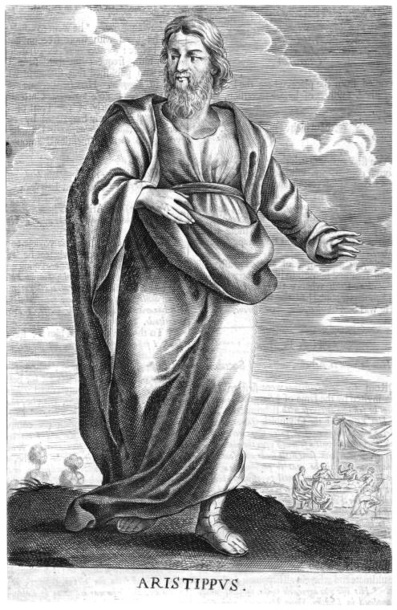
Aristippus of Cyrene. From Thomas Stanley, The History of Philosophy: containing the lives, opinions, actions and Discourses of the Philosophers of every Sect, illustrated with effigies of divers of them (1655).
image via Wikiquote (it) "Aristippo" <http://it.wikiquote.org/wiki/Aristippo>
なんか人気がないのか、絵が見つかりません。
☆ ☆ ☆ ☆ ☆
Denis Diderot, "Regrets sur Ma Vielle Robe de Chambre" E-text at Project Gutenberg <http://www.gutenberg.org/cache/epub/13863/pg13863.html>
WordRefference.com: Online Language Dictionaries [English to French, Italian, German & Spanish Dictionary] <http://www.wordreference.com/>
ホーソーンの『タングルウッド物語』 _Tanglewood Tales_ by Nathaniel Hawthorne [ひまつぶし]
ホーソーンの Tanglewood Tales (1853) は同じくギリシア神話を少年少女向けの読み物に書き直した Wonder Book の続篇で、そのことは初版の長めのタイトルが "Tanglewood Tales, for Girls and Boys; Being a Second Wonder-Book" (あるいは表紙には "Another Wonder-Book") であったことに明示されています。タングルウッドはマサチューセッツ州バークシャー・・・・・・というと以前に記事「ジーン・ウェブスター/『あしながおじさん』関連地名 Place Names in Daddy-Long-Legs [Daddy-Long-Legs]」で書いたように、『あしながおじさん』でジュディーが2年生の夏に旅行する避暑地です。あと、どっかで書いたつもりになっていたけれど見つかりませんが、バークシャー丘陵内の Greylock (最高峰)や Lenox (町の名)というのはメルヴィルやホーソーンの読者にはなじみの地名です。そしてレノックスの町の、ホーソーンが住んだあたりの地所がのちにホーソーンに因んでタングルウッドと呼ばれることになりました。
ホーソーンが1850年の春3月、有名な『緋文字』の出版のすぐあとにTappan という人からコテッジを借りてレノックスに一家で移り住み、1年半ちょっと暮らします。バークシャー時代、ホーソーンの筆は最盛期と言ってもよく、序文が有名なThe House of the Seven Gables (1851)もThe Blithedale Romance (1852) もここで書かれました。でも1851年11月にはまた引っ越してしまいます。どうもホーソーンはここの土地と合わなかったみたい。でもメルヴィルと出会ったのもこの地で1850年8月のことです。
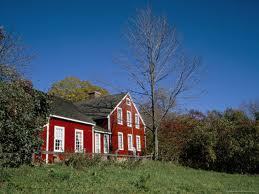
Nathaniel Hawthorne's Cottage at Tanglewood Where He Wrote The House of the Seven Gables (Photo:Christopher Rennie)
image: PostersGuide
この土地の子供たちに語り聞かせるかたちで Wonder-Book は語りが構築されていますけれど、次女は1850年にレノックスで生まれたばかりとはいえ、長女の Una と長男の Julian Hawthorne はもう本が読めるくらいの年になっていたでしょうから、子供向けの本というのを一見 grim で sober なホーソーンが子供たちへの愛情から構想したのでしょうか。それとも売れ筋市場を予想したのでしょうか。ともあれ、Wonder-BookとTanglewood Tales は(現代の研究者にはまともに読まれないけれど)一般・子供読者には19世紀後半よく読まれる本となりました。Boys and Girls じゃなくて Girls and Boys という順序は、女子(読者)のほうを上に置いているんでしょうか。
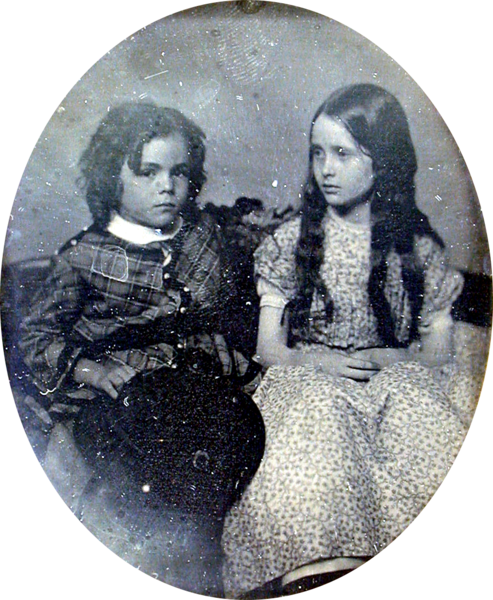
Julian Hawthorne (1846-1934) and Una Hawthorne (1844-77) c.1850
image via Wikipedia <http://upload.wikimedia.org/wikipedia/commons/6/62/Una_and_Julian_Hawthorne_c1850.png>
1852年に A Wonder-Book for Girls and Boysを、翌1853年に Tanglewood Tales をボストンの出版社 Ticknor から出版しますが、管理人のタッパンがホーソーンを記念してコテッジの名をタングルウッドとした。それからあたりの別荘もタングルウッドと名づけ、それが代がくだって1930年代にボストン交響楽団の最初の当地でのコンサート後に土地ごと寄付されて、音楽と結びついた地所の名として知られるようになったみたい。
ということで、いまはジャズやクラシックの音楽祭で有名ですかね。
さて、ウォルター・クレインが挿絵を描いている Wonder-Book のほうにだけ目が向いていて、Tanglewood Tales を見なかったのですけれど、そちらに Proserpine (Persephone) の話が入っていました。そして Golden Fleece の話もそちらに入っておったのでした。
Tanglewood Tales
The Wayside―Introductory
1. The Minotaur
2. The Pygmies
3. The Dragon's Teeth
4. Circe's Palace
5. The Pomgranate Seeds
6. The Golden Fleece
ウィキペディア(英語)は丁寧に関係を書いています。――
Tanglewood Tales for Boys and Girls (1853) is a book by American author Nathaniel Hawthorne, a sequel to A Wonder-Book for Girls and Boys. It is a re-writing of some of the most famous of the ancient Greek myths in a volume for children.
The book covers the myths of:
- Theseus and the Minotaur (Chapter : "The Minotaur")
- Antaeus and the Pygmies (Chapter: "The Pygmies")
- Dragon's Teeth (Chapter: "The Dragon's Teeth")
- Circe's Palace (Chapter: "Circe's Palace")
- Proserpina, Ceres, Pluto, and the Pomegranate Seed (Chapter: "The Pomegranate Seed")
- Jason and the Golden Fleece (Chapter: "The Golden Fleece")
//////////////////////////////////////
☆Nathaniel Hawthorne. Tanglewood Tales, for Girls and Boys; Being a Second Wonder-Book. Boston: Ticknor, Reed, and Fields, 1853. [1st American edition. With fine [というかfive] illustrations.] Google E-Book <http://www.archive.org/details/tanglewoodtales01hawtgoog>; MSN <http://www.archive.org/stream/tanglewoodtalesf00hawt5#page/n11/mode/2up>
★With illustrations by George Wharton Edwards. Tanglewood Tales. Boston: Houghton, Mifflin, 1889. <http://www.archive.org/stream/tanglewoodtalesf00hawt2#page/n7/mode/2up>
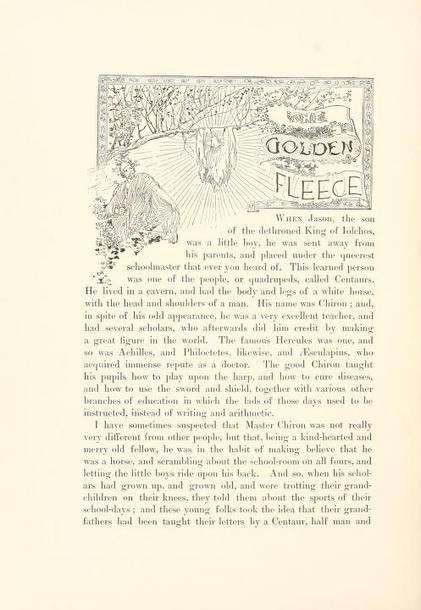
Headpiece to "The Golden Fleece." Illustraed by George Wharton Edwards. p. 154
☆A Wonder-Book for Girls and Boys (Including "Tanglewood Tales"). With Illustrations. London: George Routledge and Sons, 1868. 〔These Stories are also published in two separate vols., price 2s. each, cloth, as―I. A WONDER-BOOK FOR GIRLS AND BOYS. WITH FOUR ILLUSTRATIONS. II. TANGLEWOOD TALES: A SECOND WONDER-BOOK. WITH FOUR ILLUSTRATIONS〕 213+261pp. <http://www.archive.org/stream/wonderbookandtan00hawt#page/n7/mode/2up>
★With illustrations by Maxfield Parrish. A Wonder Book and Tanglewood Tales for Girls and Boys. New York: Duffield, 1910. <http://www.archive.org/stream/wonderbookandtan00hawt#page/n7/mode/2up>
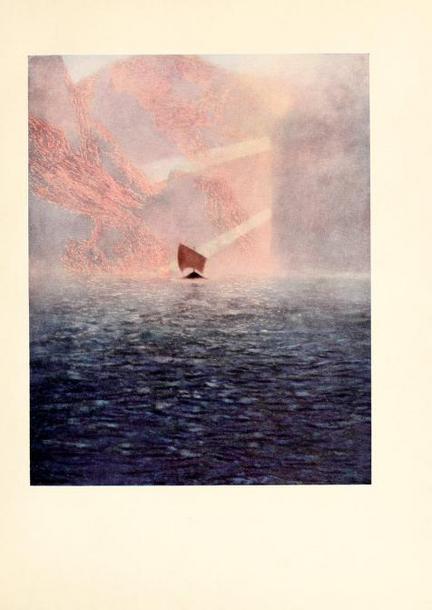
The Argonauts in Quest of the Golden Fleece (From the original in the collection of Harry Payne Whitney, Esq're New York). Illustrated by Maxfield Parrish. p. 340.
★With illustrations by Milo Winter. Tanglewood Tales. Chicago: Rand McNally, 1913. 283pp. <http://www.archive.org/stream/cu31924022254167#page/n7/mode/2up>
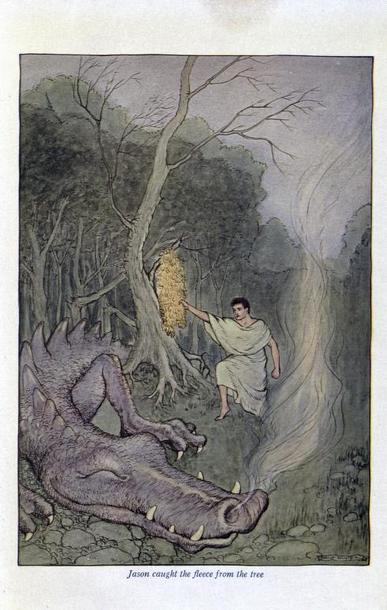
Jason caught the fleece from the tree. Illustrated by Milo Winter. Opposite to page 282.
★With illustrations by Virginia Frances Sterrett. Tanglewood Tales. Philadelphia: Penn Publishing, 1921. <http://www.archive.org/stream/tanglewoodtales00hawt#page/n7/mode/2up>
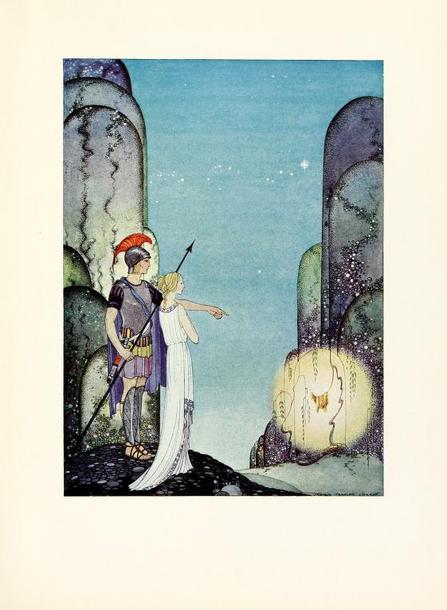
"What Is it?" Asked Jason. Illustrated by Virginia Frances Sterrett. Between pp. 256-257.
★With illustrations by Edmund Duluc. Tanglewood Tales. London and New York: Hodder and Stoughton, c1918. 245pp. <http://www.archive.org/stream/tanglewoodtales00hawt2#page/n7/mode/2up> 〔このエドマンド・デュラック挿画を使った邦訳が神宮輝夫訳『ギリシア神話物語』上下 (新書館)〕
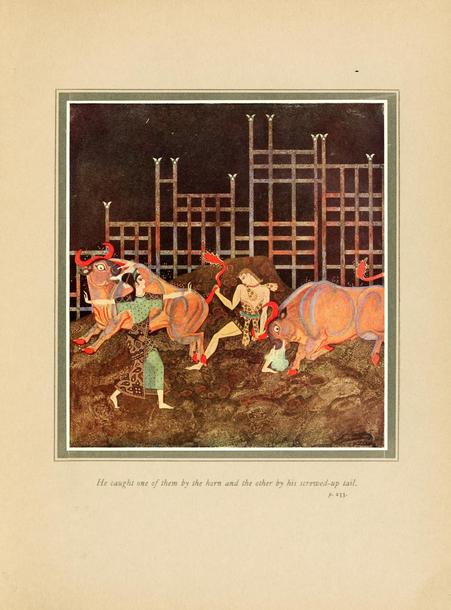
He caught one of them by the horn and the other by his screwed-up tail. p. 233. Illustraetd by Edmund Duluc. Opposite to page 209.
★Anonymous Illustrator. Tanglewood Tales. London and Edinburgh: William Blackwood and Sons, 1894 [Blackwoods' Educational Series]. 160pp. 〔タイトルとはずれがあり、Wonder-Bookから3篇、Tanglewood Tales から3篇〕 <http://www.archive.org/stream/tanglewoodtales00hawtgoog#page/n7/mode/2up>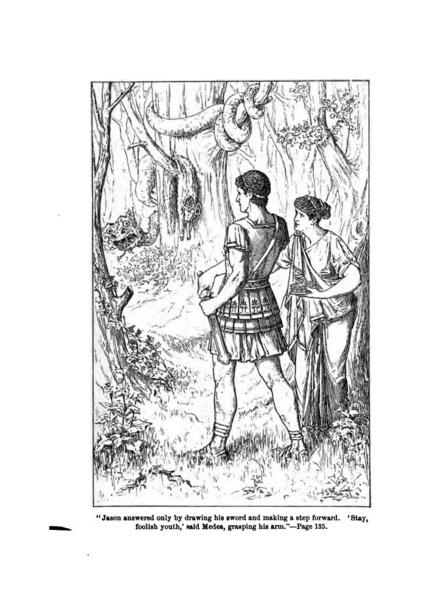
frontispiece.
『タングルウッド・テールズ』のホートン・ミフリン版の序文 Preface to the Riverside Edition of _Tanglewood Tales_ [父と子]
Internet Archive で Tanglewood Tales を閲覧して、いちばん目に留まるエディションはボストンのHoughton Mifflin 社が1898年ごろに出した "Riverside Literature Series" でした。 ホートン・ミフリン社のリヴァーサイド・プレスは1881年くらいからホーソーンの作品集さらに全集を出している出版社です(たとえば Hawthorne's Works, Illustrated Library Edition の Tanglewood Tales, and Biographical Stories (1881))。なお、このころ既に妻のソファイアは亡くなっており、ホーソーンの本の「版権」(copyright)を管理していたのは次女のRose でした。
20世紀のオハイオ大学の Century Edition 20巻本のホーソーン全集が現在の定本ですけれど、その前のホーソーン全集は1880年代~90年代の Riverside Edition 13巻本(15巻本(1882)もあり、12巻本もあったけど)で、それは『カリフォルニア時間』の記事「November 26 メリーマウントのメイポールの挿絵について An Illustration of "The Maypole of Merry Mount" [本・読み物 reading books]」で書き写したように、 "Riverside Edition / THE COMPLETE WORKS OF NATHANIEL / HAWTHORNE, WITH INTRODUCTORY / NOTES BY GEORGE PARSONS / LATHROP / AND ILLUSTRATED WITH / Etchings by Blum, Church, Dielman, Gifford, Shirlaw, / and Turner / IN TWELVE VOLUMES / VOLUME ○○." と各巻冒頭に記されていました。
この "introductory notes" を記している George Parsons Lathrop というのは、実はローズのだんなだった人です。ローズ・ホーソーンはタングルウッドというかレノックスで1851年に生まれるわけですが、その後父親のホーソーンが、大学の同級だったピアスの大統領選キャンペーン用に伝記を書いた返礼として外国領事の仕事を得た関係で、ロンドン、パリ、フィレンツェ、ローマなど、ヨーロッパで教育を受けます。そして1864年のホーソーンの死後、作家を志して詩作をしたりしました。1871年、ハワイ生まれでニューヨーク、ドレスデンで教育を受けた若い作家・詩人のGeorge Parsons Lathrop (1851–1898) とロンドンで結婚。Rose Hawthorne Lathrop を名乗ります。のちに夫ともにカトリックに転向。1895年離婚。
詩人としての筆は折って、ホーソーン家の家名復興に心をくだいたようです(母親の1871年の死につづいて、姉のユーナは1877年に亡くなっています。兄さんのジュリアンは多作な作家になりますけど、問題起こして評判落としますし)。晩年はカトリックのシスターになって社会運動に力を注ぎました。
全集版、ならびに単行本で "G. P. L" のイニシアルで序文を書いているのは、ですからホーソーンの娘の夫のジョージ・パーソンズ・レースロップです。
以上、前置き。
"Riverside Literature Series" Edition of Tanglewood Tales <http://www.archive.org/stream/tanglewoodtalesf00hawt3#page/n1/mode/2up>
INTRODUCTORY NOTE.
TANGLEWOOD TALES.
Hawthorne's first "Wonder-Book" was so well received, that he was induced to undertake another within eighteen months from the time of finishing the first. To this new volume, made up in the same way of Greek myths retold with a modern, free, half realistic and half fanciful tone, he gave the name "Tanglewood Tales." The previous series having been ostensibly narrated by one Eustace Bright, among the hills of Berkshire, these additiional stories in the like vein were represented as having been brought by Eustace Bright to Hawthorne, at his new home, The Wayside, in Concord.
This place Hawthorne had bought and moved into, early in the summer of 1852, after finishing "The Blithedale Romance" at West Newton, during the preceding winter.1 Some slight references to it are made in the Introduction headed "The Wayside," where "my predecessor's little ruined, rustic summer-house, midway on the hill-side," is mentioned. The predecessor was Mr. A. Bronson Alcott, one of the so-called Transcendental school of thinkers, the intimate friend of Ralph Waldo Emerson, and the father of Miss Louisa M. Alcott, since become one of the most popular of writers for children. This summer-house, therefore, becomes to the mind a sort of station between the new generation and the old, a link between Hawthorne in his capacity of tale-teller to the little folks of America, and the woman who, at that time a child, has in later years assembled from the young people a vast audience of her own. The romancer speaks of this rustic structure in a letter to George William Curtis, dated July 14, 1852: ―
"Mr. Alcott expended a good deal of taste and some money (to no great purpose) in forming the hill-side behind the house into terraces, and building arbors and summer-houses of rough stems and branches and trees, on a system of his own. They must have been very pretty in their day, and are still, although much decayed, and shattered more and more by every breeze that blows."
No vestige of this sylvan edifice now remains.
Prior to his return to Concord and installation at The Wayside, Hawthorne had contemplated giving up that humble abode at Lenox, which, in a letter to George William Curtis, he had called "the ugliest little old red farm-house you ever saw," and renting the country-seat of Mrs. Fanny Kemble, in the same vicinity. But as I have mentioned in the Introductory Note prefixed to the "Wonder-Book," he had already begun to languish somewhat in the inland air of the Berkshire Valley; added to which was the not altogether favorable influence of the striking scenery in that picturesque mountain-district. In October, 1851, he wrote from Lenox to a friend: "We shall leave here (with much joy) on the first day of December."
The sojourn at West Newton, however, served only to occupy the interval between Lenox and his settlement at Concord. After he had arrived at the latter place, he wrote to Horatio Bridge (October 13, 1852): "In a day or two I intend to begin a new romance, which, if possible, I intend to make more genial than the last." The "last" was "The Blithedale Romance;" but of the newly projected work here mentioned we find no further trace, and it is impossible to conjecture what scheme for a fresh work of fiction was then occupying the author's mind. The "campaign" Life of Franklin Pierce had already been produced after his coming to The Wayside, and he was apparently free to turn his attention to this projected romance; but instead of pursuing the design, whatever it may have been, he took up the composition of the "Tanglewood Tales," which were completed in the early spring of 1853. On the 13th of March, that year, he wrote the preface for them. Ten days later his appointment to the consulate at Liverpool by President Pierce was confirmed by the Senate of the United States.
G. P. L.
ホーソーンが引っ越した先のコンコードの Wayside の家の直前の持ち主がブロンソン・オールコットだったことから、児童文学の系譜としてホーソーンと娘のルイーザ・オールコットのつながりに触れています。ルイーザ・メイ・オールコット (1832-88) の両親はフェミニズムを含む進歩的な思想に傾倒していましたが、母親のAbigail は1877年まで生きて『若草物語』の Mrs. March のモデルとなっています。オルコットは生涯独身を通して、父親の超絶主義哲学者ブロンソン・オルコット (Amos Bronson Alcott, 1799-1888) が亡くなった1888年3月4日の二日後に55歳の生涯を閉じています(「醜いわが子――子らよのパート3 My Hideous Progeny: My Chillun, Part 3」参照w)。ローズ・ホーソーンの母親のソファイアもフェミニズムや擬似科学も含めて進歩的・社会改良的な思想に傾倒したひとでした(ナサニエル・ホーソーンは惹かれながらも反発しました)。
[Riverside Edition] A Wonder-Book, Tanglewood Tales, and Grandfather's Chair. Vol. 4 of The Complete Works of Nathaniel Hawthorne. Boston and New York: Houghton Mifflin, 1892 <http://www.archive.org/stream/wonderbook00hawtrich#page/n11/mode/2up>
13巻本全集の第4巻。全集には子供向けの物語がまとめておさめられ、それぞれにG. P. レースロップの序がついています。
メナンドロス Menander [辞書・辞典・事典類]
(まえおき) 研究社英和大辞典は「大英和」と通称されてきました。『研究社英和大辞典』は1927年の初版刊行以来日本の英和辞典をリードし、かつて英文科の学生は持っていて当然とは言わずとも引いて当然とされた時代がありました。「大辞典」というのは "unabridged(非省略・非簡略)dictionary" の訳語と考えられます。2002年に出た第6版『新英和大辞典』は収録項目26万と、同じ研究社の『リーダーズ英和辞典』第2版(1999年)の27万より少ないですが、概して説明や用例はより丁寧です。第6版で初めて「新」を付けて、初版の編集主幹だった岩崎民平の名がはずされたと記憶しています(編集代表が音声学が専門の竹林滋になった)。
昨晩、古代ギリシアの劇作家の Menander を電子辞書版の大英和で引いたら、つぎのような画面が出ました。というのは正確にはウソで、文字サイズをあげました。――
「新喜劇」が笑いどころではないですw
もしかして大英和のせいでメナンドロスではなくてナメンドロスが広まっているかと、「ナメンドロス」をWebで検索したらたった1件だけヒットしました。
しかし、考えてみると、ナメンドロスだと思っていたらNamender とか引くと思うし、いや、そもそもなんのために辞書を引くのか、みたいに頭がくるくるまわったのでした。パラドクス。わけわかめ。
あー、あと大英和は「ギリシャ」と表記するんですよね。遠いむかしは自分もギリシャだった(小中高校ではそうだったと思う)けれど、このごろギリシアと書くようになっています。ちなみに記事「イニシアル(イニシャル) (1) Initials」などで扱ったinitialはイニシャルと普段なら書くのですけど、意味が違うということで大胸概ねイニシアルにしました。・・・・・・と、はたと大英和で initial を引くと「イニシアル」になっていました。ははは。
////////////////////////////
「研究社の英和辞典」 Where are we going?―大学入試と英語学習のバックアップ・サイト <http://www.where-are-we-going.com/study-guide-entry/choosing-fromamong-ej-dics/kenkyusha/>




.jpg)
